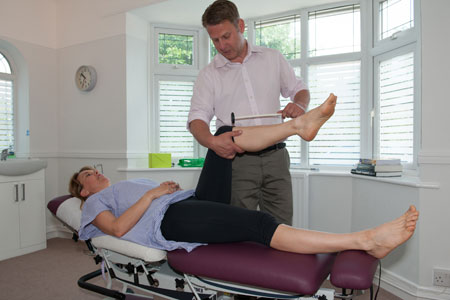
Knee

Are you suffering from any of the following symptoms which are often linked to knee pain?
- Painful knees
- Swelling
- Weakness
- Joint restriction
The knee is probably the most common joint problem we see at Back to Health after the shoulder.
The knee joint is a simple hinge joint. Movement occurs in only one plane and strong ligaments prevent twisting and torsion.
Conditions most commonly & successfully treated
- Ligament tear/sprain - often caused during sporting activities, sprains involving the ligaments around the knee can usually be treated without surgery and leave little or no restriction in sporting activities.
- Meniscus tear - the meniscus is small ridge of cartilage around the surface of the lower leg (tibia) which is designed to hold the upper leg (femur) in place. Problems with the meniscus are often intermittent and very sharp when they occur.
- Chondromalacia patella - is usually seen in adolescent athletes and is cause by poor biomechanics of the muscles surrounding the knee joint
- Iliotibial Band Syndrome (ITB) - lateral knee pain related to running. This may be related to poor foot mechanics, such as dropped arch, causing abnormal loads on the knee joint.
- Tendonitis - usually a result of repetitive stress through the knee joint, tendonitis is characterised as a sharp, hot pain with associated swelling and inflammation.
- Osgood-Schlatter’s disease - seen in young athletes complaining of pain and swelling below the kneecap. Repetitive stress causes the patellar tendon to become inflamed.
Whether the onset of the pain is traumatic or non-traumatic is critical for a correct diagnosis

Traumatic onset, because of a fall, trip or during exercise is most likely a muscle strain or ligament sprain. The location of symptoms is usually sufficient to make an accurate diagnosis. Muscle help move a joint and ligaments help restrict too much movement. Therefore, when a joint is strained, both the ligaments and muscle are injured, and the joint is prone to further injury until both have fully healed. Returning to activity too soon is likely to cause a recurrence.
Treatment consists of encouraging a strong repair and avoiding relapses. Injured tissue takes up to three months to heal properly but the pain phase is usually short-lived. As a result, people often try to do too much before full repair has occurred, since they are soon out of pain. It is not uncommon to re-injure the same tissue again, causing more damage and prolonging the recovery.
Knee pain can be caused by muscle strain around the knee joint, injury to the knee, or may be referred pain from the spine. More chronic and severe knee pain may be due to wear & tear of the joint cartilage (osteoarthritis) or by progressive inflammation and stiffening of the joint (rheumatoid arthritis). Knee problems are commonly associated with mechanical dysfunction of the spine, pelvis or feet.
Pain on weight bearing and during or after exercise could be due arthritic problems or cartilage damage. This can be quite excruciating on certain movements, as the cartilage is caught in the joint between the upper and lower leg.
Your physiotherapist or chiropractor will aim to identify the root cause and outline a plan of treatment.
Did you know?
Our clinics are centres of excellence for the treatment of back, neck and joint pain





